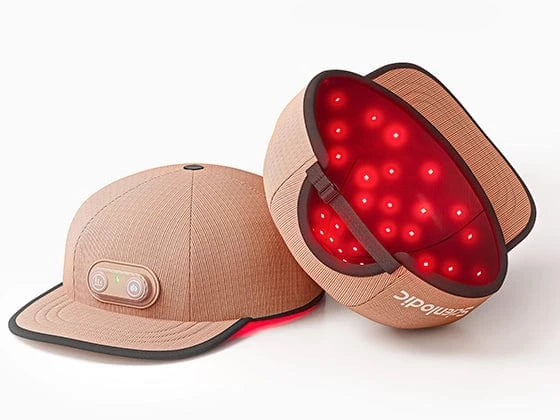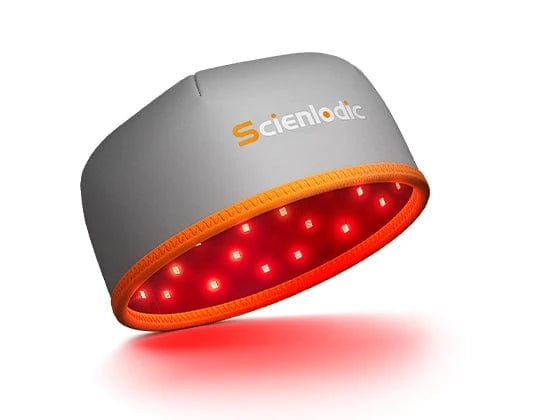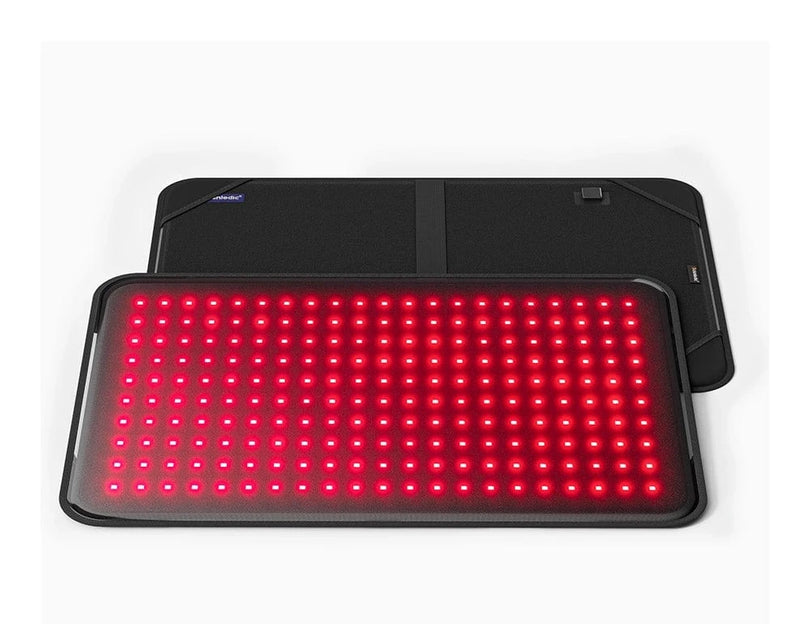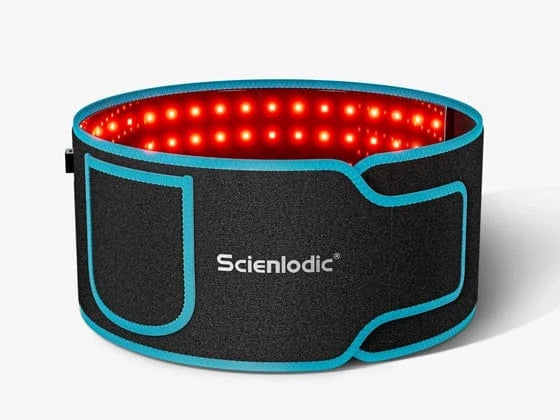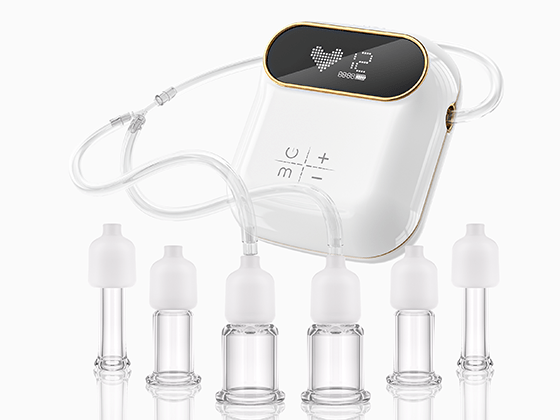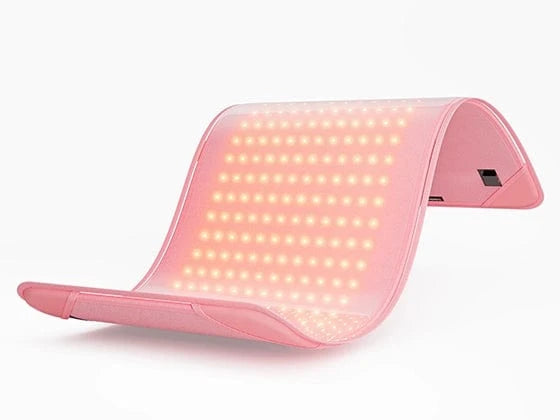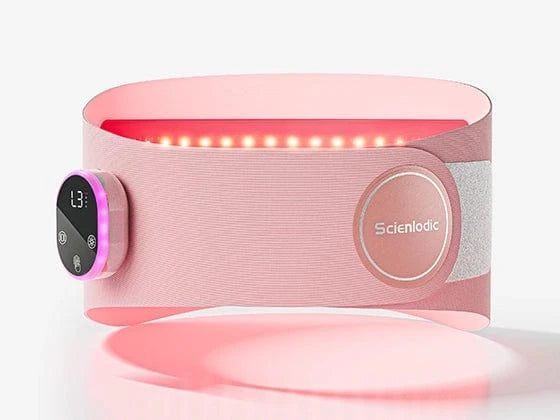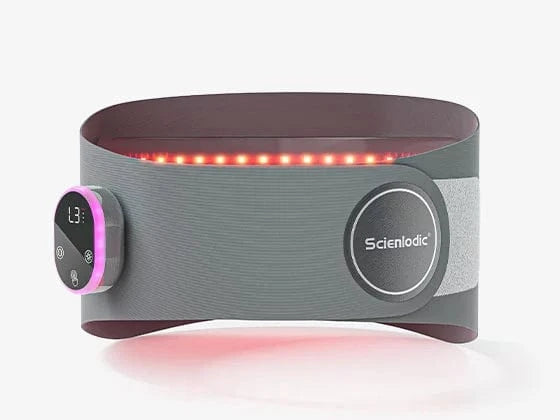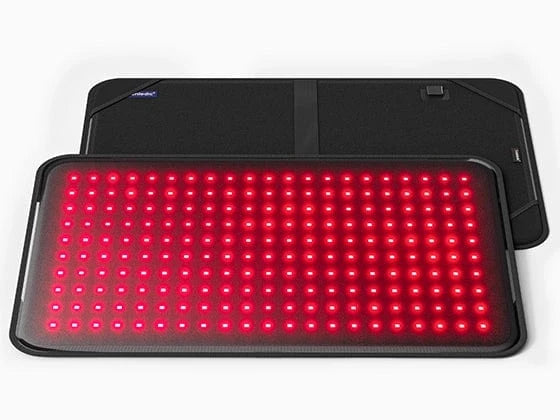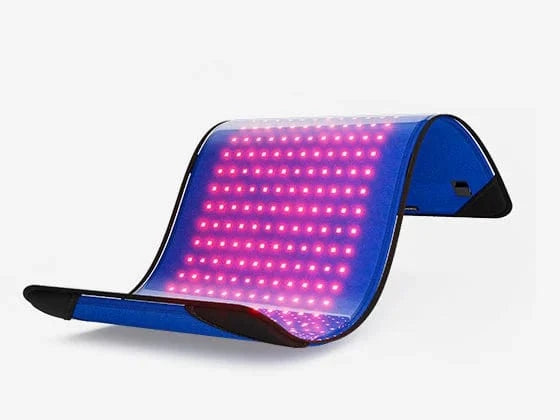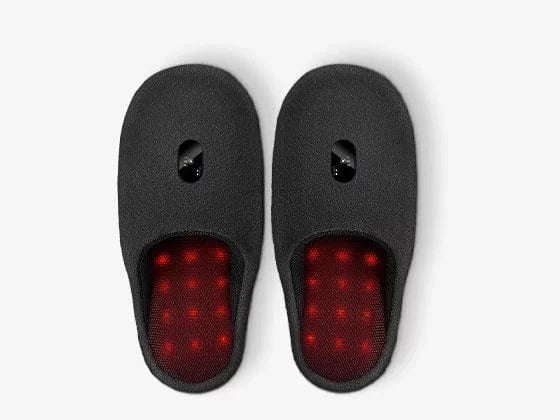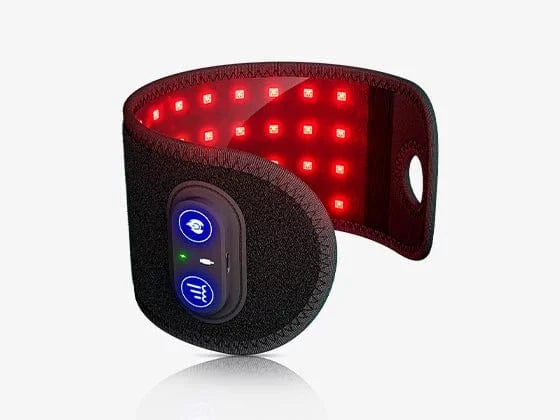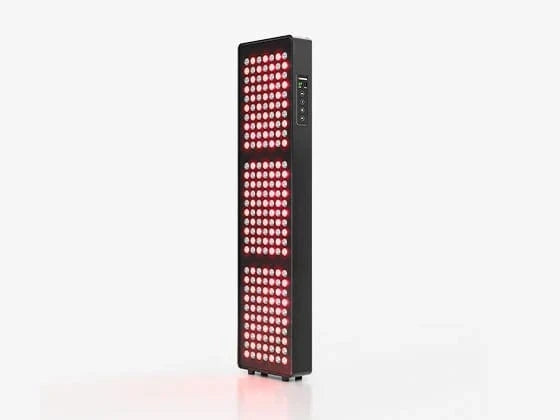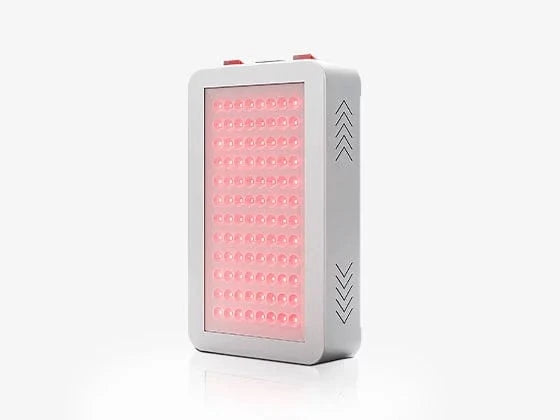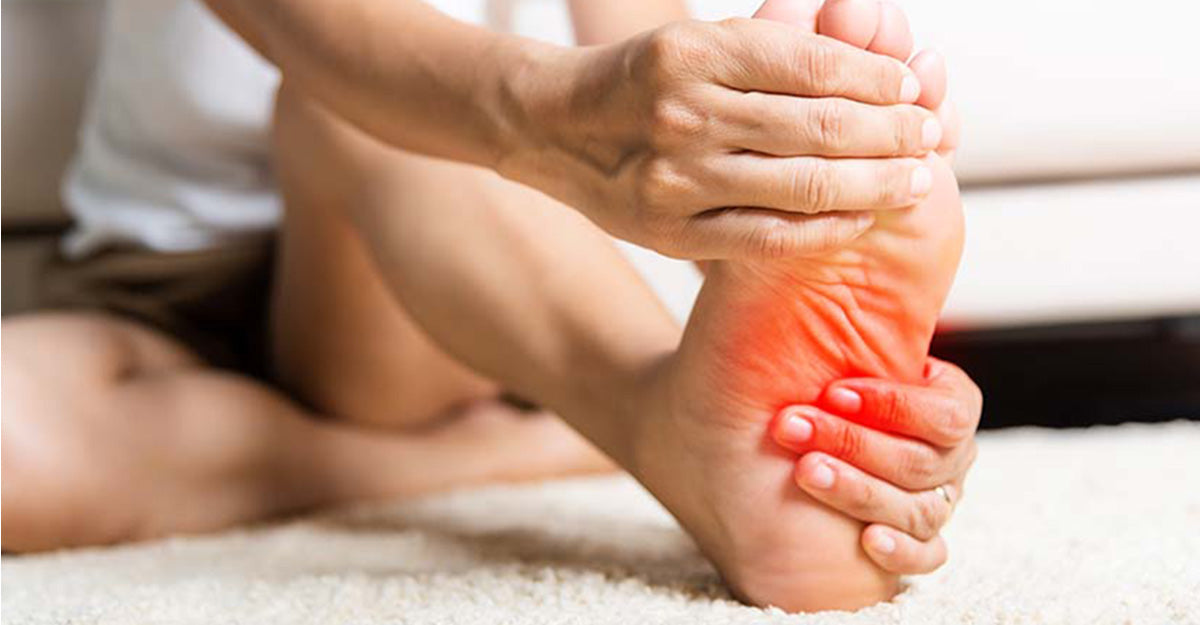Hair loss is a common problem caused by genetics, age, hormonal changes, certain medications, illness, or stress. It can be a source of embarrassment and frustration. Fortunately, red light therapy has shown promising results in promoting hair growth by stimulating hair follicles.
This article explores the science of red light therapy for hair growth, discusses its benefits and potential side effects, and provides usage instructions for combating hair loss. To be honest, this might be the most detailed article on red light therapy for hair growth that you can find.
We have prepared this outline to make it easier for you to read and find the information you need. You can read it according to your needs. Of course, if you are unfamiliar with red light therapy, reading it from beginning to end would be the better choice!
Table of Contents
- What Causes Hair Loss?
- Does Red Light Therapy Actually Help Hair Growth?
- How Does Red Light Therapy Help Hair Growth?
- Unique Benefits of Red Light Therapy for Hair
- Why Use Red Light Therapy for Hair Growth at Home?
- How to Choose the Best Red Light Therapy Device for Hair Growth
- Best Red Light Therapy Devices for Hair Growth
- How to Use Red Light Therapy for Hair Loss
- Red Light Therapy for Hair Growth: Side Effects
- Some Tips for Promoting Hair Growth
- Conclusion
- Additional Resources
If you are experiencing hair loss, red light therapy is definitely a treatment option worth considering. With proven evidence, it can help restore your confidence and improve your quality of life, so you can feel great about yourself again.
After reading this article, you should be ready to use red light therapy to regain a full head of hair. So without further ado, let's get started!
What Causes Hair Loss?
Before delving into how red light therapy can help with hair growth, it's important to understand the causes of hair loss.
As our diets become poorer and pollution increases, hair loss is becoming increasingly common. According to current statistics, by the age of 30, 25% of men and 12% of women experience hair loss. Losing between 50 and 100 hair strands per day is normal.

There are many common causes of hair loss, including:
- Genetics: The primary genetic cause of hair loss is androgenetic alopecia, also known as male or female pattern baldness, which is often related to age. It is a pervasive cause of hair loss for both men and women. In the United States, this type of hair loss affects approximately 50 million men and 30 million women.
- Hormonal changes: Women may experience hair loss during menopause due to changes in estrogen and progesterone levels.
- Scalp infection: Infections on the scalp may result in areas that are scaly and inflamed. You may notice small black dots on your scalp. In some cases, this may lead to the development of a bald spot.
- Medications: Certain medications, such as chemotherapy drugs, antidepressants, and oral contraceptives, can cause hair loss.
- Nutritional deficiencies: Nutritional deficiencies, such as low protein intake or a lack of vitamins B and iron, can cause hair loss.
- Autoimmune diseases: Autoimmune diseases can cause scarring and hair loss.
Both men and women can experience hair loss for various reasons, including physical factors like tying your hair too tightly, as well as illnesses or medications. Red light therapy cannot change your genetics, but it can activate the vitality of your cells, thereby slowing down or even reversing hair loss problems at the root level.
Does Red Light Therapy Actually Help Hair Growth?
Red light therapy has been shown to be effective in promoting hair growth. Studies have shown that red light therapy can increase the number of hair follicles and improve the overall density of hair. As a result, RLT can lead to thicker, fuller hair and help restore confidence in those experiencing hair loss.
In 2014, Joaquin J Jimenez et al. conducted a large medical experiment to evaluate the efficacy and safety of red light therapy in treating male and female hair loss. After much effort, the researchers screened a total of 146 male and 188 female hair loss patients.
The subjects were divided into an experimental group and a placebo group and were treated three times a week for a total of 26 weeks.
The study found that the treatment group experienced a significant increase in hair density, while the placebo group did not show any significant changes. Therefore, it has been proven that red light therapy is effective for both male and female hair loss patients.

This photo presents the before and after of a patient's hair growth after receiving Red Light Therapy. The top photo shows the patient before treatment, while the bottom photo shows the patient after treatment.
First, we can see that the patient's overall hair density has changed significantly, which is the effect we were expecting! Secondly, when we look closer, the micrograph on the right shows that new hair has grown under the action of red light, and the diameter of existing hair has also increased, becoming thicker and healthier.
Coincidentally, a new clinical study in 2017 showed that using a device with a 650nm LED to shine on the scalp can safely and effectively treat female patients aged 18–60 with androgenetic alopecia.
In this multicenter randomized controlled trial, researchers found that red light therapy performed every other day for a total of 17 weeks increased hair density by 51%. These results suggest that light therapy may play an important role in treating androgenetic alopecia.
In 2021, Pietro Gentile and Simone Garcovich reviewed and evaluated the research on red light therapy and hair loss over the past few decades. In this large-scale evaluation, they searched several professional research databases, such as PubMed, MEDLINE, Embase, etc. Of the 36 articles selected, 23 were clinical trials, and 13 were systematic reviews.
The study's conclusion is encouraging, as all the selected and analyzed articles reported positive effects of light therapy on treating male and female hair loss.
More importantly, there were no side effects.
Thanks to these professional researchers, we now discover that red light therapy shows promising hair growth results and is an excellent treatment for hair loss. However, even with ample evidence of the effectiveness of red light therapy, we can't help but wonder: is red light therapy really that magical? How does it work?
Don't worry. Let me explain in detail.
How Does Red Light Therapy Help Hair Growth?
Red light therapy works by stimulating the hair follicles. Red light therapy reaches the hair follicles through the skin, activating the production of ATP, which is the primary energy source for cells. The increased production of ATP can lead to increased hair growth.
As we mentioned at the beginning of the article, hair loss is a symptom. Many reasons can lead to this symptom, and they may coexist.
For example, a person may naturally secrete more male hormones, making them more prone to hair loss; they may also like to tie their hair tightly; or even their lifestyle and diet may not be very healthy. These factors stack up and cause more and more hair loss.
Below, we'll figure out what additional benefits red light therapy can provide besides stimulating ATP production and making hair follicle cells more energetic, helping us achieve better and fuller hair.
Fighting Androgenetic Alopecia (AGA)

Androgenetic alopecia is a genetically determined condition caused by an overreaction to androgens. This condition affects up to 50% of men and women and can cause gradual hair loss at any time after puberty, resulting in a receding hairline and baldness at the crown of the head. AGA is also one of the major factors that most people face when it comes to hair loss.
Fortunately, we have found relevant experiments that show promising results for red light therapy in treating AGA. In August 2013, researcher Hyojin Kim and others organized a large-scale experiment on red light therapy, attempting to study whether it has any actual therapeutic effects on AGA.
The study adopted a randomized, double-blind, placebo-controlled trial design for 24 weeks. 40 AGA patients were recruited and received 18 minutes of treatment per day. The treatment device emitted red light with 630, 650, and 660 nanometer wavelengths.
After 24 weeks of treatment, the hair density of the treatment group was significantly higher than that of the placebo group. In addition, the average improvement in hair diameter was remarkably better than that of the placebo group. Therefore, it is proven that red light therapy is an effective treatment for AGA.
Reducing Inflammation

Inflammation is a defense mechanism, but long-term low-level inflammation can negatively affect the body. If you suffer from chronic inflammation, your immune system will be overactivated and attack healthy cells, therefore, causing hair loss.
The good news is that hair loss caused by inflammation is a temporary condition that can usually be reversed. Studies have shown that red light therapy can reduce chronic inflammation by increasing blood flow, relieving pain, and reducing chronic or acute inflammation.
In 2017, an excellent researcher, Michael R. Hamblin, reviewed the mechanism of red light therapy for inflammation. Multiple experiments have shown that red light therapy can reduce inflammation in various body parts, including the head, brain, abdomen fat, wounds, lungs, and spinal cord.
It is worth noting that the paper states that many wavelengths in the red (600–700 nm) and near-infrared (NIR, 770–1200 nm) spectral regions show positive anti-inflammatory results. However, other wavelengths, such as 700–770 nm, as well as blue and green wavelengths, did not show effective results.
Reduce Autoimmune Diseases

Even without inflammation, excessive autoimmune reactions can cause our immune system to attack our own cells, including hair follicle cells. This condition is called Alopecia Areata (AA). The key to preventing hair loss is to reduce this type of stress response in the body.
Alopecia Areata (AA) is one of the three common causes of hair loss; the other two are Androgenetic Alopecia (AGA), also known as male pattern baldness, and chemotherapy-induced hair loss. AA is a common autoimmune disease.
The process of using red light therapy to fight AA differs from that of AGA discussed earlier. Red light can "calm down" your immune system and make it less aggressive. In more technical terms, red light causes T cells to attack the high-inflammatory environment surrounding hair follicles, transforming it into an environment with less inflammation.
When the immune system's overreaction is suppressed, your hair follicle cells will be safer, reducing hair loss.
Similarly, let's take a look at the experimental results and professional conclusions of frontline researchers.
In 2003, Masashi Yamazaki researched whether red light therapy is effective for alopecia areata. To conduct the study, they locally irradiated infrared light on 15 patients who were diagnosed with alopecia areata and exhibited patchy hair loss symptoms. The results showed that the hair growth rate in the treated scalp area was much higher than in the untreated area.
Only one participant reported a side effect, which was a complaint of a slight heat sensation in the irradiated area. They all achieved significant hair growth results.
Unique Benefits of Red Light Therapy for Hair
In addition to promoting hair growth, red light therapy has several other benefits.
The above research shows that red light can provide multiple benefits. It can help improve your scalp's overall health, reduce inflammation, and increase blood flow, leading to healthier hair and scalp.
As a non-invasive therapy, red light therapy has many advantages compared to traditional hair loss treatments in many aspects. So, what are the traditional treatments for hair loss? What unique advantages does red light therapy have?
Medicine

There are various medicines available to treat androgenetic alopecia (pattern baldness). The most common drugs include:
-
Minoxidil (Rogaine). Minoxidil is an over-the-counter drug. Minoxidil needs to be applied to the scalp to achieve the best results. Minoxidil-containing products have been known to aid in hair regrowth or slow down hair loss. It is recommended to use Minoxidil for at least 6 months to prevent further hair loss and promote hair regrowth. If this method is effective, you will need to continue using the drug to maintain the effect for a long time.
-
Finasteride (Propecia) is a prescription drug only suitable for men, and you need to take this pill daily. Many men who take finasteride may experience a slowdown in hair loss, and some may even grow new hair. You may need to continuously take the drug for several months to determine its effectiveness.
Finasteride may not be effective for men over the age of 60. Rare side effects include decreased libido, decreased sexual function, and an increased risk of prostate cancer. Pregnant or potentially pregnant women should avoid contact with crushed or broken tablets. In addition, finasteride is a prescription drug, which means you need a doctor's prescription to purchase it, which is inconvenient.
In fact, red light therapy is an excellent alternative therapy that can be used with the two drugs mentioned above to speed up hair growth. However, compared with these two drugs, the most prominent advantage of red light therapy is that many studies have shown that red light therapy has almost no side effects and can be used comfortably every day.
Hair Transplant Surgery

During a hair transplant procedure, a medical professional removes hair from a donor site on the patient's scalp and transplants it to the area where hair loss has occurred. The procedure does not require hospitalization, but it can be painful, so the doctor may give you some sedatives to ease any discomfort. Possible risks include bleeding, bruising, swelling, and infection. Multiple surgeries may be necessary to achieve the desired result.
In addition, although hair follicles have been transplanted, genetic hair loss will eventually prevail because hormone action has not been altered. What's the even worse part? Hair transplant surgery is usually not covered by insurance.
Compared with hair transplant surgery, red light therapy cannot restore your hair within a week. Nothing is faster than surgery. But if you want a healthier, painless, and fundamentally changing solution to hair loss, then red light therapy is clearly the better (and more economical) choice.
Laser Therapy

The working principles of laser therapy and red light therapy are very similar. Although laser experiments began in the 1960s, it was not until the 1990s that LED light was discovered for therapeutic use. However, all available evidence currently suggests that the therapeutic effects of red and infrared light are just as good as those of red lasers.
The difference is that laser therapy usually requires a professional operation, as lasers have high power, and improper use can cause burns. More seriously, if you accidentally expose your eyes to high-energy lasers, you may permanently lose your vision.
Red light therapy is relatively gentle and usually only requires wearing protective goggles. There are also red light devices specifically designed to treat eye diseases.
In addition, lasers have two major drawbacks worth noting.
One is that the light emitted by laser devices is more concentrated, which is good for achieving focused treatment effects, but the downside is very obvious—it is too focused. We want a head of uniform and thick hair, not clumps of weeds. Red light therapy is not so focused, allowing light to be evenly distributed throughout your scalp, allowing you to achieve overall hair improvement.
Also, laser devices are usually expensive (we will mention their general price below), while red light therapy based on advanced LED technology is much cheaper due to its mature manufacturing process.
You can subscribe to our newsletter to learn more about red light therapy for hair growth. We regularly share the latest information, usage guides, and before-and-after comparisons for red light therapy. We also provide free professional red light consultation services. After understanding your true situation and corresponding needs, we will try to tailor a treatment plan for you, recommend suitable products (but not the most expensive), and offer exclusive discounts.
So why not give it a go?
Why Use Red Light Therapy for Hair Growth at Home?
One of the benefits of red light therapy is that it can be done at home. Compared to hair transplantation, which requires you to lie perfectly still on a cold operating table, red light therapy serves as an affordable treatment for hair loss at home.
In addition, there are two other benefits to performing red light therapy at home:
Cost Effective
We conducted a survey in California, collecting data from about 15 places that offer red light therapy, including clinics and spas. If you want to book a 30-60 minute red light therapy session, you need to pay about $40-70 (not including tips, transportation, and parking fees).
At-home red light therapy devices can be used repeatedly. If we continue red light therapy for a year, the cost of home treatment will be thousands of dollars less than external treatment.
Therapy Anytime and Anywhere
Red light therapy sessions outside require appointments and take up a portion of your time, during which you can do nothing other than wait. With a red light device at home, you can do other things during treatment, such as yoga, meditation, watching TV, or handling emails.
How to Choose the Best Red Light Therapy Device for Hair Growth
There are many types of red light devices on the market, and we can divide them into wearable devices, handheld devices, and large panels. You can find the differences between the three by looking at the pictures below.

Generally speaking, handheld devices and panels are not suitable for hair growth.
Handheld devices are convenient to use to treat multiple areas. But their shortcomings are also obvious. For example, they do not provide adequate overall scalp coverage, and the red light cannot uniformly act on the entire scalp. The same is true for red light panels.
In addition, holding the device by hand and conducting 20 minutes of red light therapy every day can cause arm soreness.
The best hair growth device must be wearable, allowing you to easily wear it like a hat and start red light therapy. Moreover, you can do other things while undergoing treatment, making red light therapy as easy and enjoyable as eating a bag of potato chips.
When selecting at-home red light therapy devices, the following points are important to pay attention to:
Choose the Right Wavelengths
The appropriate wavelength is crucial for red light therapy. Multiple studies have shown that 630, 650, and 660 nm wavelengths can provide effective results for hair growth.
Additionally, although early research primarily used red light (600-700 nm), it was later discovered that near-infrared (NIR) light (760-1000+ nm) is equally (if not more) effective.

We don't have to be too concerned about the most effective wavelength. If possible, more wavelengths would be better. Therefore, choosing a device with both red light (630-660nm) and near-infrared light (760-1000+ nm) can give you the best and most comprehensive hair growth results.
Choosing LED Devices
Currently, red light therapy devices on the market can be divided into two categories: LED and laser. As mentioned earlier, lasers can be dangerous if not used properly, so it is best to have professionals operate them.
Although LED technology appeared later, it has developed much faster than lasers due to its wide applicability. Therefore, as of 2023, LED red light therapy devices will be a safer and more cost-effective choice.
Choose Products that are Comfortable to Wear
One of the major advantages of conducting red light therapy at home is comfort. Therefore, when selecting a hair growth red light device, we should also consider comfort.
Some brands, in order to forcefully create a professional concept, directly use industrial-style helmet designs. However, if you carefully study user reviews, you will find that the feeling of wearing this type of device is not good.
Hair growth helmets on the market are often quite heavy, and all the weight is concentrated on specific points (as you can see in the picture), making the treatment experience unpleasant and affecting the hair growth in the compressed areas.

Therefore, before purchasing, be sure to check the material and choose a soft and breathable hair growth device if possible.
Timer and Automatic Shut-Off Function
Safety is absolutely important. Although red light therapy has few side effects, it is also important not to overtreat as much as possible.
Make Sure You Get an FDA-cleared Device
Due to the rapid development of red light therapy, some unqualified suppliers have also started selling red light devices, making the whole market relatively chaotic.
Therefore, even if you don't choose a well-known brand, you should go for FDA-cleared and medical-grade devices. Verified devices can guarantee the effectiveness and safety of treatment.
After understanding the standards for purchasing red light devices, let's look at the best batch of hair growth red light therapy products, their respective prices, and differences in functionality. After reading, I believe you will be able to make a purchase decision.
Best Red Light Therapy Devices for Hair Growth

Scienlodic Red Light Therapy Hair Growth Hat $199.99
Pros
FDA-cleared
Multi-wavelength treatment
Affordable prices
Designed for the home
Safer and more efficient LED light source
Cons
Not stylish enough
Scienlodic's hair growth cap is an FDA-cleared product that uses 120 of the most advanced composite medical-grade LEDs. It combines a wavelength of 660+850nm red and near-infrared light to provide the best hair growth results.
We also have an additional 10 and 40 Hz pulse function. Conversely, pulses can provide cells with an extremely short "cooling time," allowing your follicle cells to better absorb red light energy. On the other hand, pulses have additional benefits for brain diseases and stress relief.
We may be the first brand to try to implement the concept of "mobile therapy." Therefore, you can easily start red light therapy almost anywhere.
Lastly, but most importantly, we are really affordable.
This affordability is not at the expense of product quality and efficacy. On the contrary, when we first entered this industry, we found that top brands were trying to maintain very high prices, and no one would easily lower them, but doing so would not allow everyone to enjoy the benefits of red light.
Therefore, we conducted in-depth research on the supply chain and tried reorganizing it. As a result, we can provide excellent product quality while keeping our prices much lower than our competitors. Therefore, we hope everyone can try red light therapy, and it should not be the privilege of a few.


iRestore Laser Hair Growth System $695-1195
Pros
FDA approval
Highest laser power output
Cons
Less affordable price
Risks of laser operation for non-professionals
iRestore is expensive. Though it includes more lasers and output power than similar devices on the market. As an established brand, it provides additional post-purchase assurances and a larger number of customer reviews.
The advantages and disadvantages of this product are very clear. If you are financially strong and care about the brand's reputation, then iRestore may be among the few choices.
The disadvantage is that the laser device is more dangerous, and you need more knowledge of red light therapy. In addition, due to the construction of the hard helmet, the comfort of wearing it is naturally not as good as that of a soft red light device.
According to feedback from multiple real users, you can see that during the actual treatment process, the hard laser helmet will cause great trouble for users in terms of effectiveness and comfort.


Therefore, be cautious if you want to buy a laser hair growth device.

Hairmax Ultima 12 LaserComb $399.00
Pros
FDA approval
Clinically proven brands
Easier localized treatment
Cons
Longer time to results
Risks of laser operation for non-professionals
Requires frequent manual operation
HairMax devices are often used for research, and the Ultima12 laser comb has been clinically validated. It contains 12 medical-grade lasers, powerful enough to treat thinning areas.
Compared to other laser hair growth devices, the price of this device is relatively affordable. It is also easy to use. Just comb your hair through a few times. However, this advantage can also become a disadvantage.
As this product is a comb, in order to achieve the best therapeutic effect, you need to repeat a single combing action frequently every day or week so that each hair follicle can fully receive the therapeutic effect of red light.
As we all know, red light therapy requires continuous use for a long period of time to be effective, which is why most brands (including ours) recommend using it for at least 3 months. So, if you bought a hair growth cap, you just need to wear it regularly. However, if you buy a red light comb, the amount of handwork required for daily red light therapy increases, which makes things a bit more complicated.
The more complicated things are, the harder it is to stick to them. Sometimes, simpler things are better. From this perspective, I still prioritize recommending wearable devices.
Whether or not you already have a satisfactory hair growth red light therapy device, I recommend you continue reading. Before starting red light therapy in practice, it may be more helpful to understand how to use it.
How to Use Red Light Therapy for Hair Loss
After obtaining a satisfactory red light hair growth device, it is important to use it correctly to achieve the best hair growth results. First and foremost, do not get too excited after receiving the new device and take your time to carefully read the instructions. As the power and settings of each brand and product vary, the usage method will also vary accordingly.
Below are the usage instructions, taking our Scienlodic Red Light Therapy Hair Growth Hat as an example. If you have a similar LED hair growth product, you can also use it directly according to our instructions.
First, let's answer the two most commonly asked questions.
How Often to Use Red Light Therapy for Hair Growth?
Generally speaking, if you are new to red light therapy, it is best to maintain a frequency of at least 3 times a week. After 1-2 weeks, you will begin to adapt to and enjoy the feeling of red light therapy. At this point, you can slowly increase the frequency of treatment from 3 times a week to 5-6 times a week or even daily use.
Stick with it for about a month, and then observe changes in hair growth. Generally, people with a faster metabolism will begin to see fine hair growth after 1-2 months; for others, it may take 3 months or longer to see significant changes (after all, no one will observe their scalp with a microscope).
How Long to Use Red Light Therapy for Hair
Red light therapy sessions typically last between 10 and 30 minutes. However, the recommended duration of use varies depending on the device and the manufacturer's instructions.
Similar to the treatment frequency, I recommend doing red light therapy for 10 minutes each time if you are a beginner. It is better to increase the frequency rather than the duration, as this can help your body quickly adapt to red light therapy and also help establish a good therapy schedule.
After 1-2 weeks, if you feel good, gradually increase the duration of the treatment. Generally, one home red light therapy session will not exceed 30 minutes.
I believe that soon you will be able to find the most suitable rhythm for your own red light therapy.
Red Light Therapy for Hair Growth: Side Effects
Kim et al. conducted a 24-week clinical trial to test if red light therapy could promote hair growth as an alternative treatment for patients who do not respond well to drugs. They found that the treatment group showed significantly higher hair density than the placebo group (those who received no treatment).
More importantly, they did not find any adverse effects.
In addition, red light therapy did not show any side effects in all the experiments we have summarized above. Therefore, we can say that red light therapy is unlikely to cause side effects when used properly.
Though red light therapy is generally considered safe, some potential side effects exist. These can include skin irritation, redness, and dryness. In addition, it is worth noting that some people are naturally sensitive to high-intensity light, and a few drugs may interact with light.
So, talking to a healthcare professional before starting red light therapy is important to ensure it's safe for you.
Many users have asked us the following two questions, and we will answer them together here to clarify any doubts:
Can Red Light Therapy Cause Hair Loss?
Red light therapy has not been shown to cause hair loss.
In fact, this article is an attempt to research and prove the effectiveness of red light therapy for hair growth. Therefore, when its effectiveness is proven, the rumor that red light therapy causes hair loss is also debunked.
Does Red Light Therapy Cause Facial Hair?
Our users have not reported excessive facial hair growth during actual use. However, in principle, red light can enhance cell vitality and accelerate metabolism, so it can also be used to stimulate hair growth in any part of the body.
In addition to promoting hair growth, red light therapy is also commonly used for facial and full-body contouring. Studies have shown that red light therapy can increase blood circulation, reduce inflammation, and stimulate collagen, helping restore vitality and skin sensation. Red light therapy is also used to treat cellulite and stretch marks.
As this article mainly focuses on hair growth, we shall not delve into these topics. However, interested readers can follow the link to read more.
Above, we attempted to demonstrate through ample evidence that red light therapy for hair loss has the lowest number of side effects among many therapies. However, there are also some special cases, such as if you are photosensitive or taking photosensitive medication.
Therefore, it is important to note this before starting red light therapy. It is better to consult your healthcare professionals to determine if it is right for your situation.
Some Tips for Promoting Hair Growth

In addition to using red light therapy to regrow hair, we have prepared some tips that can help you achieve hair growth faster:
Perseverance is the key.
It is important to persist in using it, as the effects of red light therapy may not be immediately visible. Whether from user feedback or clinical studies, the entire process of red light therapy usually lasts 6 months to 1 year or even longer. Please try incorporating red light therapy into your daily activities, like eating, sleeping, and bathing.
Healthy Lifestyle Habits
Pay attention to your lifestyle habits and maintain good ones, such as drinking plenty of water and getting enough sleep, which can help your hair become healthier.
Healthy Diet Structure
Eat more protein-rich foods like meat, fish, and beans to help your hair grow healthily. Also, pay attention to consuming zinc, as it is an important nutrient that can promote hair health.
Take Good Care of Your Hair
Avoid washing your hair too frequently and minimize the use of styling tools such as hair dryers and curling irons to reduce damage to your hair. Finally, avoid frequent dyeing and bleaching of your hair to minimize chemical damage to it.
Keep Your Scalp Clean
Pay attention to scalp cleanliness and keep your scalp clean to help your hair become healthier.
Overall, maintaining healthy hair requires multi-faceted attention and maintenance. In addition to paying attention to diet and using appropriate hair care products, it is also necessary to pay attention to hair moisturizing, scalp cleansing, and lifestyle habits.
Conclusion
Thank you for reading this far. Compared to before, you now have a better understanding of the science behind red light therapy for hair growth, its therapeutic advantages and potential side effects, as well as how to use red light therapy to alleviate hair loss.
Compared to other traditional treatment methods, red light therapy is a low-risk, high-efficiency, and cost-effective treatment method, especially suitable for those who don't want to take too much risk but still want to restore hair growth.
In this article, we recommend a head-mounted red light therapy device, the Scienlodic Red Light Therapy Hair Growth Hat. It is an FDA-cleared device with 120 medical-grade composite chips and can provide the most advanced multi-wavelength treatment. At the same time, it is priced affordably, making it very suitable for home use.
In conclusion, we believe that home-use red light therapy for hair growth is a treatment method that is well worth trying. It can not only improve the growth status of hair but also improve skin conditions and promote overall health.
At the same time, we also hope that you carefully read the instructions before use, purchase FDA-cleared products, and undergo treatment under the advice of a doctor to achieve the best results.
Additional Resources
[1] https://www.mayoclinic.org/diseases-conditions/hair-loss/symptoms-causes/syc-20372926
[2] https://medlineplus.gov/genetics/condition/androgenetic-alopecia/#frequency
[3] https://my.clevelandclinic.org/health/diseases/16921-hair-loss-in-women
[4] https://jamanetwork.com/journals/jama/fullarticle/2795266
[5] Joaquin J Jimenez. Efficacy and safety of a low-level laser device in the treatment of male and female pattern hair loss: a multicenter, randomized, sham device-controlled, double-blind study. Randomized Controlled Trial Am J Clin Dermatol. 2014 Apr;15(2):115-27.
[6] Shelly Friedman, Patricia Schnoor. Novel Approach to Treating Androgenetic Alopecia in Females With Photobiomodulation (Low-Level Laser Therapy). Dermatol Surg. 2017 Jun;43(6):856-867.
[7] Pietro Gentile, Simone Garcovich. The Effectiveness of Low-Level Light/Laser Therapy on Hair Loss. Facial Plast Surg Aesthet Med. 2021 Sep 20. doi: 10.1089
[8] Chin H. Ho; Tanuj Sood; Patrick M. Zito. Androgenetic Alopecia. https://www.ncbi.nlm.nih.gov/books/NBK430924/
[9] Hyojin Kim. Low-level light therapy for androgenetic alopecia: a 24-week, randomized, double-blind, sham device-controlled multicenter trial. Dermatol Surg. 2013 Aug;39(8):1177-83. doi: 10.1111/dsu.12200. Epub 2013 Apr 3.
[10] Michael R Hamblin. Mechanisms and applications of the anti-inflammatory effects of photobiomodulation. AIMS Biophys. Author manuscript; available in PMC 2017. PMCID: PMC5523874
[11] Masashi Yamazaki, Yuko Miura, Ryoji Tsuboi, Hideoki Ogawa. Linear polarized infrared irradiation using Super Lizer is an effective treatment for multiple-type alopecia areata. Int J Dermatol. 2003 Sep;42(9):738-40. doi: 10.1046/j.1365-4362.2003.01968.x.
[12] Michael R Hamblin. Photobiomodulation for the management of alopecia: mechanisms of action, patient selection and perspectives. Clin Cosmet Investig Dermatol. 2019; 12: 669–678. PMCID: PMC6737896
[13] Kai Yang. Hair Growth Promoting Effects of 650 nm Red Light Stimulation on Human Hair Follicles and Study of Its Mechanisms via RNA Sequencing Transcriptome Analysis. Ann Dermatol. 2021 Dec; 33(6): 553–561. PMCID: PMC8577899
[14] R Lubart, Y Wollman, H Friedmann, S Rochkind, I Laulicht. Effects of visible and near-infrared lasers on cell cultures. J Photochem Photobiol B. 1992 Feb 28;12(3):305-10. doi: 10.1016/1011-1344(92)85032-p.
[15] https://www.healthline.com/health/tricks-healthier-fuller-hair

